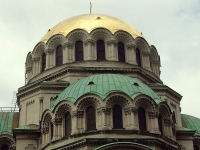
One of the finest examples of 20th-century architecture in Sofia, and one of the most iconic buildings in the city, the magnificent Alexander Nevsky Cathedral was built between 1882 and 1912 to honour the Russian soldiers who died fighting to liberate Bulgaria from Turkish rule in the war of 1878 under Tsar Alexander II. It is one of the biggest cathedrals on the Balkan Peninsula. The famous religious monument is situated in the centre of Sofia, on the tree-lined square of the same name, which also contains the Monument of the Unknown Soldier.The impressive five-nave basilica houses an interior just as splendid, with mosaics, stained glass windows, marble and woodcarvings as well as frescoes that cover the walls and domes. The underground crypt houses the Icon Museum featuring icon paintings from across the country that represents masterpieces ranging from the 9th to the 18th century. For those who fall in love with the Bulgarian icons, there is often a local artist who paints and sells replicas in the little museum gift shop. There is also a souvenir market very close by.The cathedral is an active place of worship, so services and events may disrupt sightseeing, but entry to the main building is free.
Address : pl. "Sveti Aleksandar Nevski", 1000 Sofia, Bulgaria.
The Boyana Church complex - located on the outskirts of Sofia - is a UNESCO World Heritage Site, and one of Bulgaria's most important tourist attractions. The first of the three buildings that make up the Boyana Church complex was built in the 10th century, but it is the second building - constructed in the 13th century - that is the obvious tourist draw card.Containing frescoes painted in 1259, the second Boyana Church building is nothing less than the site of the most important collection of medieval eastern European art in the world. The paintings, which conform to a Byzantine aesthetic, are almost perfectly preserved and offer visitors a rare insight into the long, proud history of Bulgarian art and culture. The church complex also houses the National Museum which boasts a rich collection of historical and cultural artefacts. It is recommended that visitors hire one of the professional guides available to give them a tour of the church and museum as they greatly enrich the experience.
Address : ул. Боянско езеро 3, 1616 Sofia, Bulgaria.
Website : www.boyanachurch.org
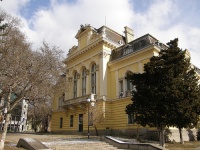
The National Ethnographic Museum in downtown Sofia has one of the richest collections of cultural artefacts on the Balkan Peninsula, representing the traditions, arts, crafts and lifestyle of the Bulgarian people from the 17th to the 20th century. The museum contains a wealth of exhibits from around the country, amounting to over 50,000 items including national costumes, jewellery, art works and musical instruments.If you are lucky, and the place is not crowded, one of the staff members may give you a personal tour. This is the best possible place to find out about local folklore and to gain an understanding of the traditional clothes (the embroidery on the borders serve a purpose in Bulgarian mythology), customs and beliefs. It is also a popular cultural and educational centre.The National Ethnographic Museum is located in the same building as the National Gallery, the old Royal Palace, and you can buy a joint ticket to see both of these worthwhile attractions if you prefer. A great museum shop on the premises sells crafts and other traditional items from all over Bulgaria - a useful place to shop for presents for those waiting at home.
Address : 1 Prince Alexander Square.
Website : bulgariatravel.org/en/object/286/Etnografski_institut_BAN
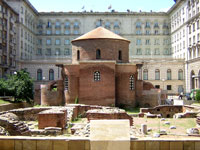
The rotunda church of St George is considered to be the oldest building in Sofia, dating back to the 4th century, and is situated amid the remains of the ancient Roman town of Serdica. The St George Rotunda is famous for its exquisite architecture and layers of medieval frescoes that were discovered under a covering of plaster.The church currently functions as a museum and the magnificent dome is protected by UNESCO. It is located in a square enclosed by the Presidential Buildings and this makes the contrast between the ancient and the modern quite striking. There is a fair amount of information on the history and significance of the site available at the entrance, which is worth reading. There is a pleasant restaurant next door to the site where you can enjoy a meal with views of the church, and if you linger for a while you might well see the guards marching by.Visitors must ensure that they are dressed appropriately and conservatively as people with bare arms or legs will not be allowed entry into the church.
Address : bul. Kniaz Aleksandar Dondukov 2, 1000 Sofia, Bulgaria.
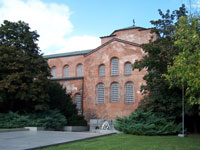
The St Sofia Church, also called the Hagia Sophia Church, is the oldest Eastern Orthodox church in the city, dating from the 4th to 6th century, and is regarded as one of the most significant examples of early Christian architecture in the Balkans. In the 14th century the church gave its name to the city of Sofia, meaning 'holy wisdom'.The church was built on the site of several earlier churches and places of worship, dating back to the days when the site was part of the necropolis of the Roman town of Serdica. As a result, several tombs have been discovered under and around the church which are incredibly interesting for history buffs.During the Turkish rule the church was converted into a mosque, but was abandoned after two successive earthquakes destroyed one of the minarets almost 30 years later, and it was again converted into an orthodox church. Local legends credit St Sofia's miraculous powers for its protection over the centuries, surviving occupations and natural disasters to remain a spiritual inspiration to the city.
Address : ul. Paris 2, 1000 Sofia, Bulgaria.
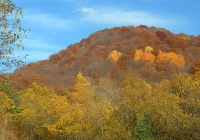
Rising above the capital city of Sofia, Vitosha Mountain is one of the symbols of the capital and is the most visited mountain in Bulgaria. Starting where the suburbs end, the whole mountain has been designated a national park - the oldest in the Balkans - and is home to deer, bear, wild boar, fox and a variety of rare birds. Vitosha is known for its 'stone rivers', or moraines, piles of huge rounded granite boulders carried and deposited by glaciers thousands of years ago, as well as for its restorative mineral springs.Vitosha is popular during all seasons and the well-known resort of Aleko is the most established winter ski resort in the area, offering modern hotels and ski facilities within easy reach of the capital. Although you could spend a good portion of your holiday enjoying this mountain and staying in its resorts, you can just as easily head up the mountain for a hike one afternoon and experience some beautiful views of the city below. There is a cable-car and several bus routes which can take you part of the way up Vitosha. There are several great picnic sites to enjoy if the weather is good and an excursion up the mountain is a lovely activity for the whole family.

Travel Guide powered by Word Travels, copyright © 2023 Globe Media Ltd. By its very nature information in this travel guide is subject to change at short notice and travellers are urged to verify information on which they're relying with the relevant authorities. Neither Globe Media Ltd nor Travel Vogue can accept any responsibility for any loss or inconvenience to any person as a result of information contained above.